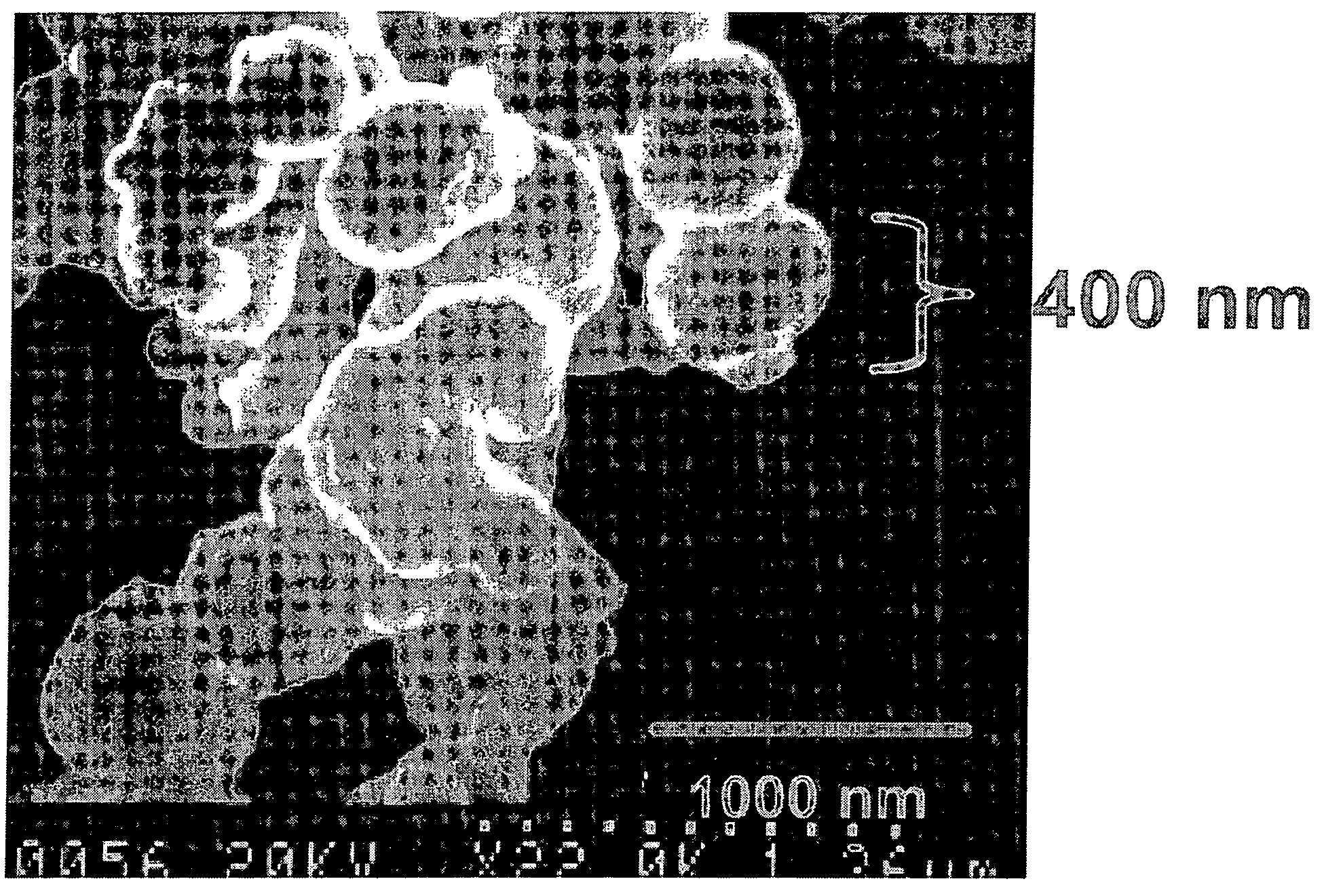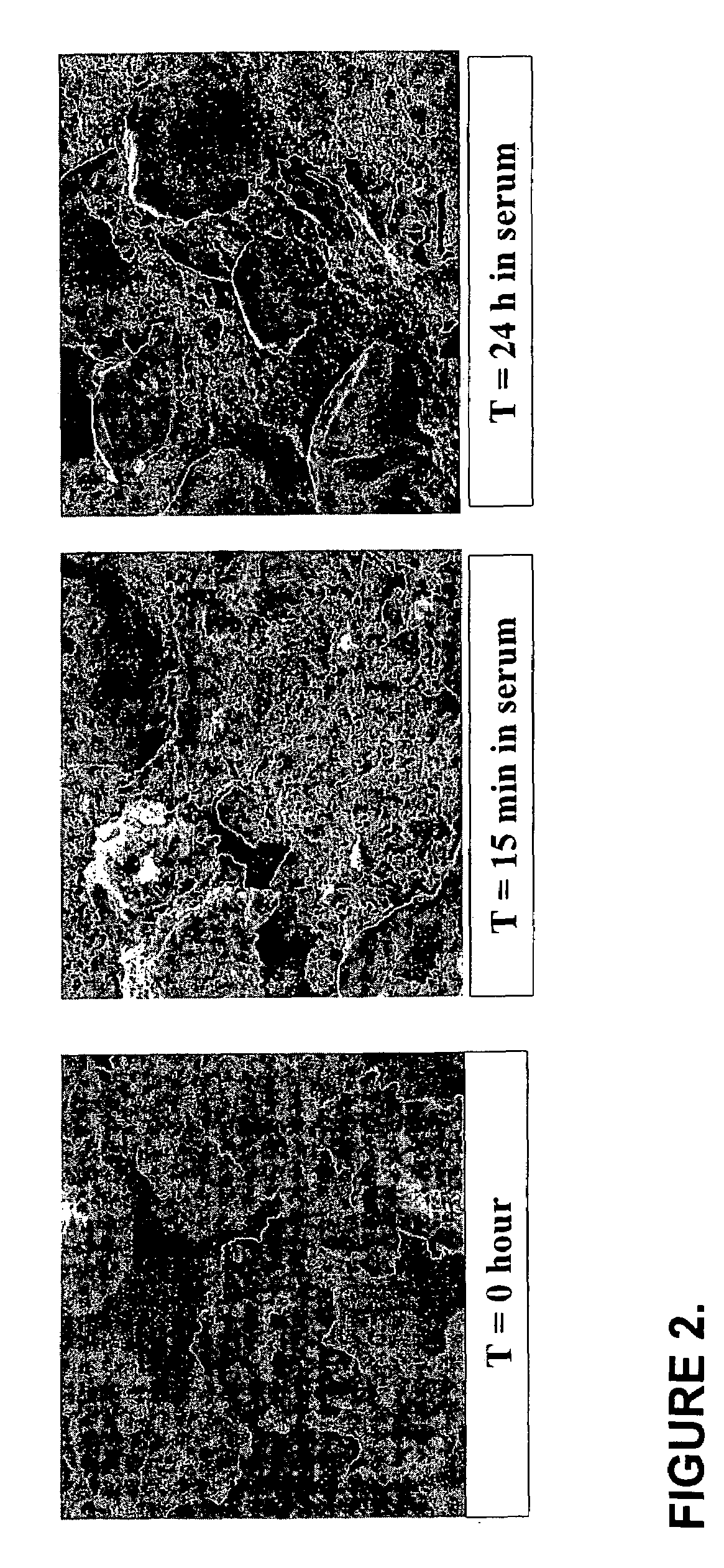Biocompatible cement containing reactive calcium phosphate nanoparticles and methods for making and using cement
a technology of reactive calcium phosphate and nanoparticles, which is applied in the field of production and use of calcium phosphate cementtype materials, can solve the problems of patient pain, lack of biocompatibility, and risk of infection during operations
- Summary
- Abstract
- Description
- Claims
- Application Information
AI Technical Summary
Benefits of technology
Problems solved by technology
Method used
Image
Examples
example 1
[0084]This example illustrates the preparation of highly reactive tricalcium phosphate nanoparticles.
[0085]The following solutions are prepared:
[0086]Solution A: A 1.0 molar solution of Ca(NO3)2 is prepared by dissolving 236 g Ca(NO3)2. 4H2O over 15 minutes in 1.0 liter of distilled, de-ionized H2O then filtering the solution through a 0.22 μm filter. In some cases, the solution may be treated with pyrrolidinedithiocarbamate (PDDC) prior to filtering. PDDC is used as a general chelating agent to trap divalent impurities like zinc, copper, nickle, etc. Those ions could have an adverse effect on the formation of highly reactive alpha-tricalcium phosphate.
[0087]Solution B: A 1.33 molar solution of (NH4)2HPO4 is prepared by dissolving 176 g (NH4)2HPO4 over 15 minutes in 1.0 liter of distilled, de-ionized H2O then filtering the solution through a 0.22 μm filter. In some cases, the solution may be treated with pyrrolidinedithiocarbamate prior to filtering.
[0088]Solution C: A 2.25 molar so...
example 2
[0093]This example illustrates the preparation of a cement powder containing the highly reactive tricalcium phosphate nanoparticles.
[0094]Approximately 9.0 g of the newly synthesized nanoparticulate TCP powder is combined with 1.0 g of CaCO3 (calcium carbonate, Mallinckrodt Analytical reagent #4072) and 1.3 g Ca(H2PO4)2.H2O (calcium bis(dihydrogenphosphate) monohydrate, Fluka Chemika, #21053) and placed in a 50 ml Zirconia ceramic vial set containing one ½″ zirconia ball (Spex-Certiprep, # 8005) and ground for 1 hour in a Spex-Certiprep 800 Mixer / Mill®.
[0095]The TCP nanoparticles at this point can be used directly for the preparation of a cement, or they can be stored for later mixing and use.
example 3
[0096]This example illustrates the preparation of lubricant liquids that can be used for the preparation of a cement paste and a biocompatible cement of the present invention.
[0097]The following solutions are prepared:
[0098]Solution E: A 0.6 molar solution of (NH4)2HPO4 containing 0.075 g polyacrylic acid per 1.0 ml solution is prepared by dissolving 79.2 g (NH4)2HPO4 and 75 g sodium polyacrylate (60,000 average molecular weight) in 1.0 liter of distilled, deionized water then filtered through a 0.22 μm filter. As an alternative, the polyacrylic acid may also be added as a dry powder to the TCP powder. The concentration of polyacrylic acid in the cement powder is 1.5% weight / weight.
[0099]Solution F: A 0.75 molar solution of sodium phosphate tribasic is prepared by dissolving 175 g Na3(PO4).12H2O in 1.0 liter of warm, distilled, deionized water. The solution is then filtered through a 0.22 μm filter.
PUM
| Property | Measurement | Unit |
|---|---|---|
| compressive strength | aaaaa | aaaaa |
| temperature | aaaaa | aaaaa |
| size | aaaaa | aaaaa |
Abstract
Description
Claims
Application Information
 Login to View More
Login to View More - R&D
- Intellectual Property
- Life Sciences
- Materials
- Tech Scout
- Unparalleled Data Quality
- Higher Quality Content
- 60% Fewer Hallucinations
Browse by: Latest US Patents, China's latest patents, Technical Efficacy Thesaurus, Application Domain, Technology Topic, Popular Technical Reports.
© 2025 PatSnap. All rights reserved.Legal|Privacy policy|Modern Slavery Act Transparency Statement|Sitemap|About US| Contact US: help@patsnap.com



